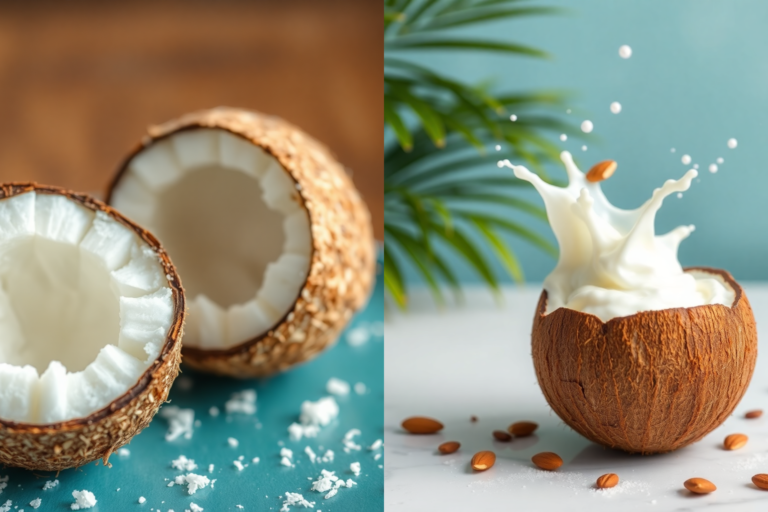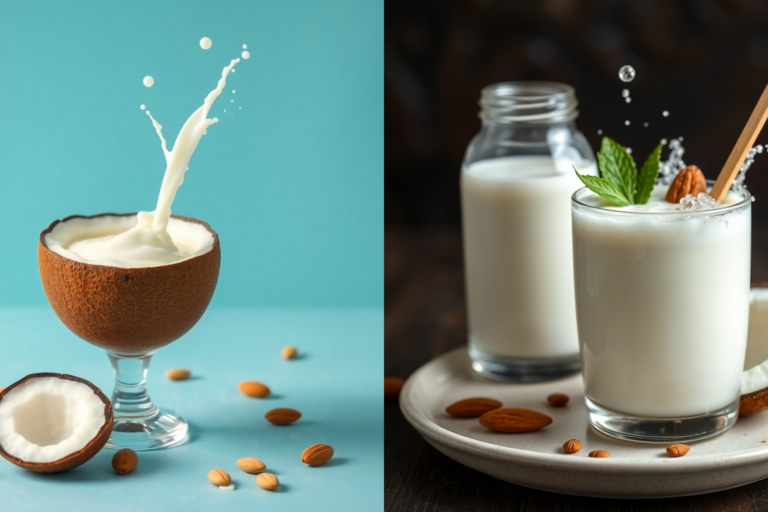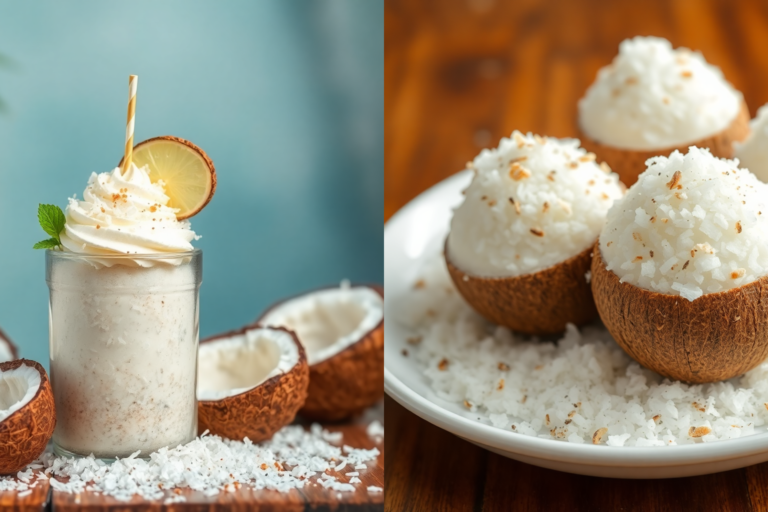Introduction: Coconut Milk vs Almond Milk
When it comes to plant-based milk alternatives, coconut milk vs almond milk are two of the most popular choices among health-conscious consumers. Both options offer unique flavors, nutritional benefits, and versatility in culinary applications, making them excellent substitutes for traditional dairy milk.
Coconut milk is derived from the flesh of coconuts and is known for its creamy texture and rich, tropical flavor. It is often used in various cuisines, particularly in Southeast Asian dishes, curries, and desserts. Coconut milk is not only delicious but also packed with medium-chain triglycerides (MCTs), which are believed to provide quick energy and promote weight loss. Additionally, coconut milk is lactose-free, making it an excellent option for those with lactose intolerance or dairy allergies.
On the other hand, almond milk is made from ground almonds and water, resulting in a light and slightly nutty flavor. Almond milk is low in calories, making it a popular choice for those looking to manage their weight. It’s also a good source of vitamin E, an antioxidant that supports skin health and boosts the immune system. Like coconut milk, almond milk is lactose-free, catering to those who prefer dairy-free alternatives.
Exploring the uses of coconut milk vs almond milk in daily diets is essential for maximizing their health benefits. Both milks can be used in various recipes, from smoothies and cereals to soups and sauces. Understanding the differences in flavor profiles and nutritional content allows individuals to select the right milk for their specific dietary needs and preferences. By incorporating both coconut and almond milk into daily meals, individuals can enjoy a delicious, nutrient-rich diet while exploring the myriad of culinary possibilities that these plant-based alternatives offer.
In summary, coconut milk vs almond milk provide flavorful, nutritious options for those seeking dairy alternatives. Whether you’re cooking, baking, or simply enjoying a refreshing drink, both milks can enhance your daily diet in delicious and healthful ways.
Use 1: Smoothies and Beverages
When it comes to creating delicious and nutritious smoothies and beverages, the choice of milk can significantly influence the flavor, texture, and overall nutritional profile of your drink. In the debate of Coconut Milk vs Almond Milk, both options offer unique characteristics that cater to different taste preferences and dietary needs.
Flavor Profiles: Coconut Milk vs Almond Milk
Coconut Milk
Coconut milk is known for its rich, creamy texture and subtly sweet, tropical flavor. Its natural sweetness pairs wonderfully with various fruits and ingredients, making it an excellent base for smoothies. Coconut milk adds a velvety richness that enhances the overall mouthfeel of the beverage. It also offers a hint of coconut flavor that complements tropical ingredients like pineapple, mango, and banana.
Almond Milk
In contrast, almond milk has a more delicate, nutty flavor with a slightly watery consistency compared to coconut milk. While it may not provide the same creaminess, almond milk’s mild taste allows it to blend seamlessly with a wide variety of fruits and flavors. It’s particularly refreshing when combined with berries, leafy greens, and spices like cinnamon or nutmeg. The lightness of almond milk makes it a fantastic choice for those looking for a less indulgent alternative.
Suggested Recipes Using Coconut Milk and Almond Milk
1. Tropical Coconut Smoothie
Ingredients:
- 1 cup coconut milk
- 1 banana
- 1/2 cup pineapple chunks
- 1 tablespoon honey (optional)
- Ice cubes
Instructions:
- In a blender, combine coconut milk, banana, pineapple, and honey.
- Blend until smooth and creamy.
- Add ice cubes and blend again for a refreshing texture.
- Serve chilled for a tropical escape.
Benefits: This smoothie is rich in healthy fats from coconut milk, providing sustained energy and a delicious tropical flavor that embodies the Coconut Milk vs Almond Milk debate.
2. Berry Almond Smoothie
Ingredients:
- 1 cup almond milk
- 1/2 cup mixed berries (strawberries, blueberries, raspberries)
- 1 tablespoon chia seeds
- 1/2 banana
- Ice cubes
Instructions:
- Combine almond milk, mixed berries, chia seeds, and banana in a blender.
- Blend until smooth and creamy.
- Pour over ice and enjoy.
Benefits: This refreshing berry smoothie highlights the nutty flavor of almond milk, providing antioxidants and fiber, making it a great choice for a morning boost.
3. Coconut Banana Protein Shake
Ingredients:
- 1 cup coconut milk
- 1 banana
- 1 scoop protein powder (vanilla or chocolate)
- 1 tablespoon peanut butter
- Ice cubes
Instructions:
- Blend coconut milk, banana, protein powder, and peanut butter until well mixed.
- Add ice for a chilled shake.
- Serve immediately for a post-workout recovery.
Benefits: The combination of coconut milk and protein powder makes this shake perfect for muscle recovery and energy replenishment, showcasing the benefits of Coconut Milk vs Almond Milk.
4. Almond Chai Smoothie
Ingredients:
- 1 cup almond milk
- 1/2 teaspoon chai spice mix
- 1 banana
- 1 tablespoon maple syrup
- Ice cubes
Instructions:
- In a blender, mix almond milk, chai spice, banana, and maple syrup.
- Blend until smooth and frothy.
- Serve over ice for a refreshing treat.
Benefits: This smoothie is a unique twist on traditional chai tea, highlighting almond milk’s versatility and allowing for a flavorful beverage that combines the best of both milks in the Coconut Milk vs Almond Milk discussion.
5. Creamy Coconut Berry Smoothie Bowl
Ingredients:
- 1 cup coconut milk
- 1/2 cup mixed berries
- 1/2 banana
- Toppings: granola, shredded coconut, fresh berries
Instructions:
- Blend coconut milk, berries, and banana until smooth.
- Pour into a bowl and top with granola, shredded coconut, and fresh berries.
- Enjoy with a spoon for a nutritious breakfast or snack.
Benefits: This smoothie bowl is visually appealing and packed with nutrients, making it an excellent choice for anyone wanting to experience the creamy texture of coconut milk while comparing it to almond milk’s lighter profile.
Coconut Milk vs Almond Milk: Cooking and Baking
Differences in Cooking Properties
When it comes to cooking and baking, understanding the differences in the properties of coconut milk vs almond milk is crucial for achieving the desired taste and texture in your dishes.
Fat Content and Creaminess
One of the primary differences between coconut milk vs almond milk lies in their fat content. Coconut milk is derived from the flesh of mature coconuts and is rich in healthy saturated fats, primarily medium-chain triglycerides (MCTs). This fat content contributes to its creamy texture, making it an excellent choice for creamy dishes, soups, and sauces.
In contrast, almond milk is significantly lower in fat and calories, primarily composed of water, with a creamy consistency that is less dense than coconut milk. This makes almond milk suitable for lighter dishes, but it may not provide the same richness that coconut milk offers. When using coconut milk vs almond milk in recipes, it’s important to consider these differences, especially when the creaminess of a dish is essential.
Ideas for Dishes That Benefit from Each Milk
Dishes that Benefit from Coconut Milk
Coconut milk’s rich, creamy texture and subtle sweetness make it a fantastic ingredient in various dishes. Here are some ideas where coconut milk shines:
Curries: Coconut milk is a staple in many Asian and Indian curries, adding depth and creaminess. The fat in coconut milk helps to meld the spices together, creating a harmonious and flavorful dish. Consider making a Thai red curry or a rich coconut chicken curry that highlights the unique taste of coconut milk.
Soups: Use coconut milk to create creamy soups, such as coconut pumpkin soup or coconut chowder. Its rich consistency enhances the soup’s body and adds a delightful tropical flavor.
Desserts: Coconut milk is an excellent base for dairy-free desserts, such as coconut panna cotta, coconut ice cream, or tropical coconut rice pudding. The natural sweetness of coconut milk pairs well with fruits and other sweet ingredients.
Dishes that Benefit from Almond Milk
While almond milk may not provide the same level of creaminess as coconut milk, it offers a lighter alternative for various dishes. Here are some ways to incorporate almond milk:
Baked Goods: Almond milk can be used in baking recipes for muffins, pancakes, and cakes. Its light texture works well in recipes where moisture is needed without the heaviness of cream. Try almond milk in banana bread or almond flour pancakes for a nutritious twist.
Smoothies: Almond milk is a popular base for smoothies, as it adds creaminess without overpowering other flavors. Blend almond milk with fruits and greens for a refreshing, nutrient-packed drink.
Oatmeal and Cereal: Almond milk can be poured over oats or cereal as a lighter alternative to regular milk, providing a nutty flavor that enhances the dish without the added calories.
Coffee and Lattes: Use almond milk in coffee or lattes for a dairy-free option that froths beautifully, allowing for delicious dairy-free cappuccinos and lattes.
Comparing Coconut Milk vs Almond Milk in Cooking
In summary, the choice between coconut milk vs almond milk in cooking and baking largely depends on the dish you are preparing and the texture you desire. Coconut milk brings a rich creaminess and depth of flavor, making it ideal for curries, soups, and desserts. In contrast, almond milk serves as a lighter, versatile option for baking, smoothies, and breakfast dishes.
When selecting between the two, consider the specific requirements of your recipe. For creamy, indulgent dishes, coconut milk is the way to go. For lighter fare and baked goods, almond milk is an excellent choice. Each milk brings its unique qualities to the table, enhancing the overall culinary experience.
Use 3: Coffee and Tea
Benefits of Using Coconut Milk and Almond Milk in Beverages
Coconut milk and almond milk are popular alternatives to dairy milk, especially in coffee and tea. Both options offer unique flavors and a creamy texture that can elevate your favorite beverages.
Nutritional Benefits: Coconut milk vs almond milk has significant nutritional differences. Coconut milk is rich in medium-chain triglycerides (MCTs), which can boost metabolism and provide quick energy. It also contains lauric acid, known for its antimicrobial properties. On the other hand, almond milk is lower in calories and is a great source of vitamin E, an antioxidant that promotes skin health. Both alternatives are lactose-free, making them suitable for those with dairy intolerance.
Flavor Profile: When comparing coconut milk vs almond milk, the flavor varies significantly. Coconut milk brings a subtle sweetness and tropical flavor, enhancing the overall taste of coffee and tea. Almond milk has a nutty undertone that adds a unique twist to beverages. Depending on your preference, either option can create a delightful experience.
Tips for Frothing and Flavor Enhancements
To achieve the perfect cup of coffee or tea with coconut milk vs almond milk, consider these tips for frothing and enhancing flavors:
Frothing Techniques: Frothing coconut milk vs almond milk can produce different results due to their unique compositions. Coconut milk typically froths well due to its higher fat content, creating a rich and creamy foam. To froth coconut milk, heat it gently before using a frother or whisk. Almond milk may require a bit more effort, but using barista-style almond milk designed for frothing can yield better results. Always ensure the milk is warmed but not boiling to achieve the best froth.
Flavor Enhancements: Both coconut milk and almond milk can be enhanced with various flavorings to complement your beverages. For a tropical twist in coffee, consider adding a splash of vanilla extract or a sprinkle of cinnamon when using coconut milk. If you prefer almond milk, try incorporating cocoa powder for a delicious mocha or a dash of cardamom for an aromatic chai. Experimenting with different spices and sweeteners can help you discover your ideal blend.
Use 4: Sauces and Dressings
The Role of Coconut Milk vs Almond Milk in Sauces and Dressings
When it comes to creating creamy, flavorful sauces and dressings, coconut milk vs almond milk brings unique qualities to the table. Coconut milk, with its rich, tropical flavor, adds a luscious creaminess that elevates dishes, while almond milk offers a nutty undertone and a lighter texture. Both types of milk can be easily incorporated into various recipes, making them versatile options for enhancing your culinary creations.
How Each Milk Can Enhance Sauces and Dressings
Coconut Milk: Known for its rich, creamy consistency, coconut milk can transform ordinary sauces into indulgent, flavorful companions for a variety of dishes. Its natural sweetness balances spicy elements and pairs beautifully with Asian and tropical flavors, making it an excellent base for curries, marinades, and salad dressings.
Almond Milk: Almond milk brings a subtle nutty flavor that can enhance dressings and sauces without overpowering other ingredients. Its lighter consistency makes it a great choice for vinaigrettes and creamy dressings, allowing for a healthier alternative without sacrificing taste. Almond milk is also lower in calories, making it a smart choice for those watching their dietary intake.
Simple Recipes Incorporating Coconut Milk vs Almond Milk
1. Creamy Coconut Curry Sauce
This sauce is perfect for drizzling over vegetables, chicken, or tofu, bringing a rich and satisfying flavor to your meals.
Ingredients:
- 1 can (400ml) coconut milk
- 1 tablespoon red curry paste
- 1 tablespoon soy sauce or tamari
- 1 teaspoon lime juice
- Optional: Fresh herbs (like cilantro or basil) for garnish
Instructions:
- In a saucepan over medium heat, combine coconut milk and red curry paste. Stir until well mixed.
- Add soy sauce and lime juice. Simmer for 5-10 minutes, allowing the flavors to meld.
- Serve warm over your choice of protein or vegetables, garnished with fresh herbs.
2. Almond Milk Vinaigrette
This light vinaigrette is perfect for salads or drizzling over roasted vegetables, providing a nutty flavor that enhances any dish.
Ingredients:
- 1/4 cup almond milk
- 1/4 cup olive oil
- 2 tablespoons apple cider vinegar
- 1 teaspoon Dijon mustard
- Salt and pepper to taste
Instructions:
- In a bowl, whisk together almond milk, olive oil, apple cider vinegar, and Dijon mustard until smooth.
- Season with salt and pepper to taste. Adjust the acidity by adding more vinegar if desired.
- Drizzle over salads or use as a marinade for vegetables.
3. Coconut Lime Dressing
This dressing is refreshing and perfect for summer salads, bringing a tropical flair to your meals.
Ingredients:
- 1/2 cup coconut milk
- 2 tablespoons lime juice
- 1 tablespoon honey or agave syrup
- Salt to taste
Instructions:
- In a bowl, whisk together coconut milk, lime juice, and honey until well combined.
- Add salt to taste and adjust sweetness if necessary.
- Serve over mixed greens or use as a dip for fresh vegetables.
4. Creamy Almond Milk Alfredo Sauce
This vegan version of Alfredo sauce is a lighter take on the classic, perfect for pasta or as a base for pizza.
Ingredients:
- 1 cup almond milk
- 1 tablespoon olive oil
- 3 cloves garlic, minced
- 1/2 cup nutritional yeast
- Salt and pepper to taste
Instructions:
- In a saucepan, heat olive oil over medium heat and sauté minced garlic until fragrant.
- Add almond milk and nutritional yeast, stirring until well combined.
- Season with salt and pepper to taste, and allow to simmer for a few minutes until slightly thickened.
- Toss with your favorite pasta or drizzle over pizza.
Use 5: Dairy Alternatives in Breakfast
Elevate Your Morning Routine with Coconut Milk vs Almond Milk
Breakfast is often touted as the most important meal of the day, and choosing the right dairy alternatives can make it both nutritious and delicious. Both coconut milk and almond milk serve as excellent substitutes for traditional dairy, providing unique flavors and nutritional benefits. Whether you’re enjoying cereals, oatmeal, or pancakes, incorporating Coconut Milk vs Almond Milk into your morning routine can transform your breakfast into a delightful experience.
Why Choose Coconut Milk and Almond Milk?
Nutritional Benefits
Coconut Milk vs Almond Milk offers a variety of health benefits that can enhance your breakfast choices.
Coconut Milk: Made from the flesh of coconuts, it is rich in medium-chain triglycerides (MCTs), which are known for their ability to boost metabolism and provide a quick source of energy. Coconut milk is also a good source of iron, magnesium, and vitamins C and E, supporting overall health and well-being.
Almond Milk: This plant-based milk is made from ground almonds and is naturally low in calories. It is rich in vitamin E, an antioxidant that supports skin health, and is also a good source of calcium if fortified. Almond milk is heart-healthy due to its low saturated fat content and can help in maintaining healthy cholesterol levels.
Taste Considerations
When it comes to flavor, Coconut Milk vs Almond Milk brings distinct characteristics to your breakfast dishes.
Coconut Milk: Its rich and creamy texture adds a tropical flair to your meals. The subtle sweetness of coconut can enhance the flavor profile of your breakfast, making it an excellent choice for sweeter dishes like pancakes and cereals.
Almond Milk: Almond milk has a mild, nutty flavor that pairs well with a variety of breakfast items. It works particularly well in oatmeal and smoothies, adding a light, refreshing taste without overpowering the other ingredients.
Incorporating Coconut Milk and Almond Milk into Your Breakfast
Cereals: Pouring Coconut Milk vs Almond Milk over your favorite cereal can change the way you experience breakfast. Coconut milk’s creamy texture can make even the simplest cereals feel indulgent, while almond milk offers a lighter option that still provides essential nutrients.
Oatmeal: For a hearty bowl of oatmeal, consider using either milk as a base instead of water. Coconut milk adds a rich creaminess and a hint of sweetness, making your oatmeal feel more luxurious. Almond milk, on the other hand, keeps it light and allows the flavors of added fruits and nuts to shine through.
Pancakes: When making pancakes, substituting dairy milk with Coconut Milk vs Almond Milk can yield delicious results. Coconut milk can create fluffy, moist pancakes with a tropical twist, while almond milk provides a nutty flavor that complements sweet or savory toppings. Both options ensure that your pancakes are dairy-free without compromising on taste.
Conclusion
In the ongoing discussion of Coconut Milk vs Almond Milk, it’s essential to recognize the unique advantages each option brings to your diet. Both of these milk alternatives offer distinct flavors and nutritional benefits, making them valuable additions to a balanced diet.
Coconut Milk vs Almond Milk: Nutritional Highlights
Coconut milk is rich in medium-chain triglycerides (MCTs), which can provide quick energy and may support weight management. It also contains healthy fats that contribute to heart health and can improve nutrient absorption. On the other hand, almond milk is lower in calories and often fortified with vitamins and minerals, such as calcium and vitamin D, making it a great choice for those seeking a lighter option without sacrificing essential nutrients. Additionally, almond milk is a good source of vitamin E, an antioxidant that supports skin health and overall wellness.
Coconut Milk vs Almond Milk: Culinary Versatility
When it comes to culinary uses, both coconut milk and almond milk shine in various recipes. Coconut milk adds a creamy texture and a hint of tropical flavor, making it perfect for curries, soups, smoothies, and desserts. Its rich consistency can transform ordinary dishes into delightful culinary experiences. Almond milk, with its nutty undertones, is an excellent choice for baking, coffee, and breakfast dishes like oatmeal or pancakes. Its lightness can enhance the flavors of fruit-based smoothies and shakes without overwhelming them.
Encouragement to Experiment
As you explore the world of dairy alternatives, we encourage you to experiment with both coconut milk and almond milk in your recipes. Whether you choose to blend them into your morning smoothie, use them in baking, or create savory dishes, there’s no limit to the creativity you can bring into your kitchen. Mixing coconut milk and almond milk can also create a deliciously unique flavor profile, combining the best of both worlds.
In conclusion, understanding the benefits and uses of Coconut Milk vs Almond Milk empowers you to make informed choices that suit your dietary preferences and culinary needs. By incorporating both into your meals, you can enjoy a variety of flavors and health benefits that contribute to a balanced and enjoyable diet. Don’t hesitate to try different recipes and discover your personal favorites—your taste buds will thank you!











